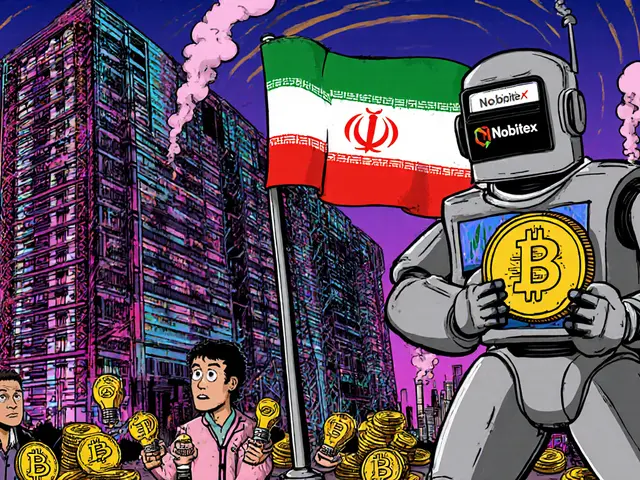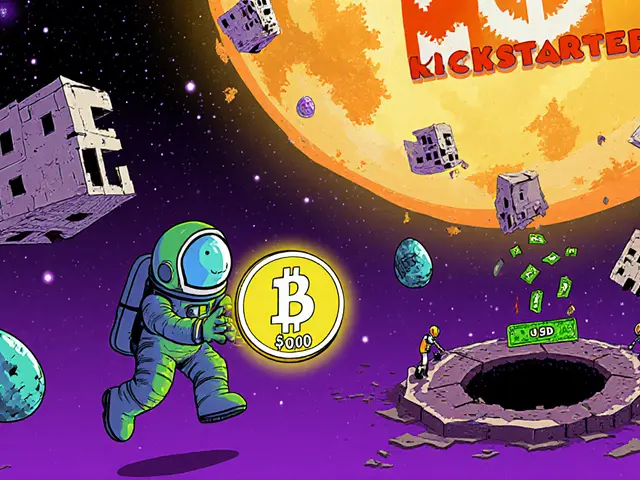MCH Earnings Calculator
Calculate Your MCH Earnings
Estimate potential token earnings from Moonchain's free hardware devices
Estimated Earnings
Important: This is an estimate based on current token economics. Actual earnings may vary due to network growth, token distribution changes, and market conditions. MCH is a volatile cryptocurrency.
Most crypto coins are just digital bets on future hype. Moonchain (MCH) is different. It’s not just another token floating in the ether. It’s a blockchain built to connect real-world hardware, AI data, and decentralized money - and it’s already putting physical devices into people’s hands for free.
What Exactly Is Moonchain (MCH)?
Moonchain is a Layer 1 blockchain launched in early 2025 that acts as the backbone for AI and IoT networks. Its native token, MCH, isn’t just used for trading. It powers everything from paying transaction fees to earning rewards when your hardware sends real-world data to the network. Think of it like a digital economy running on top of physical devices - smart speakers, solar inverters, or energy monitors - that you can get without paying upfront.
Unlike most crypto projects that rely on people buying expensive mining rigs or staking large amounts of tokens, Moonchain flips the script. Through partnerships with consumer tech brands like JBL and CyberCharge, users can receive free hardware devices that automatically mine MCH tokens just by being plugged in and connected to the internet. No upfront cost. No technical expertise needed to start.
How Does Moonchain Work?
Moonchain runs on a zkEVM (zero-knowledge Ethereum Virtual Machine), which means it’s compatible with Ethereum tools but much faster and cheaper to use. This lets it handle massive amounts of data - think petabytes from smart home devices, traffic sensors, or renewable energy systems - without slowing down.
Here’s how it works in practice:
- You sign up for an Initial Hardware Offering (IHO) through a partner like JBL or CyberCharge.
- You get a free device - often a small box or adapter - shipped to your door.
- You plug it in. It connects to your Wi-Fi and starts collecting anonymized data from your environment - like energy usage, ambient noise, or location signals.
- This data gets processed by Moonchain’s AI layer, tokenized, and sold to companies building AI models or IoT networks.
- You earn MCH tokens as a reward for contributing your device’s data stream.
The system turns everyday gadgets into mini data factories. Your smart speaker doesn’t just play music - it helps train AI models, and you get paid in MCH for it.
Why Is the IHO Model a Big Deal?
DePIN (Decentralized Physical Infrastructure Networks) projects like Helium and Filecoin have struggled for years with one problem: getting hardware into users’ hands. Buying and shipping thousands of devices costs millions. Most users won’t spend hundreds of dollars on a device they don’t fully understand.
Moonchain solved that by partnering with companies that already make consumer electronics. JBL doesn’t need to become a crypto company - they just add a Moonchain chip to their next line of Bluetooth speakers. CyberCharge slips a Moonchain module into their portable power banks. Suddenly, millions of potential users are getting hardware they already wanted - and the blockchain grows with them.
By September 2025, 86% of the first batch of IHO devices sold out in under nine hours. That’s not hype. That’s real demand.
What Can You Do With MCH Tokens?
MCH isn’t just a reward token. It’s the fuel of the Moonchain ecosystem:
- Pay transaction fees - Just like ETH on Ethereum, you need MCH to send data or interact with smart contracts on the network.
- Stake for rewards - Hold MCH in a wallet and earn more tokens by helping secure the network.
- Vote on upgrades - Token holders can propose and vote on changes to the protocol.
- Get discounts - Use MCH to pay less for premium AI data services hosted on the platform.
The token has a fixed maximum supply of 999,999,999 MCH. As of November 2025, about 241.6 million are in circulation - roughly 24% of the total. That leaves room for growth as more hardware comes online and more users join.

Where Can You Buy MCH?
Moonchain’s token trades on major exchanges, primarily through the Binance Alpha ecosystem. It’s listed as a BEP20 token on the BNB Smart Chain, meaning you can store it in any wallet that supports BSC - like MetaMask, Trust Wallet, or the Binance app.
As of September 2025, MCH had a market cap of around $184 million and traded across 30 active markets. Trading volume was often higher than the market cap itself - a sign of active, real usage, not just speculation.
While you can buy MCH on exchanges, the most unique way to get it is still through the free hardware. For many, it’s the first time they’ve ever earned crypto just by using a device they already owned.
How Does Moonchain Compare to Other DePIN Projects?
Let’s break it down:
| Feature | Moonchain (MCH) | Helium | Filecoin |
|---|---|---|---|
| Primary Use Case | AI data collection & IoT networks | Wireless hotspot networks | Decentralized file storage |
| Hardware Model | Free IHO devices via consumer brands | Users buy hotspots | Users buy storage miners |
| Token Utility | Gas, staking, governance, discounts | Staking, rewards | Storage payments, rewards |
| Market Cap (Sep 2025) | $184M | $1.2B | $850M |
| Adoption Speed | Fast - 86% of IHO devices sold in 9 hours | Slow - hardware costs and complexity | Medium - requires technical setup |
| Scalability | High - zkEVM handles petabytes of data | Low - limited bandwidth | Medium - storage-focused, not real-time |
Moonchain isn’t trying to replace Helium or Filecoin. It’s targeting a new space: AI-driven data economies. While Filecoin stores files and Helium builds wireless networks, Moonchain turns your living room into a data lab for artificial intelligence.
Who Is Using Moonchain Right Now?
Early adopters fall into three groups:
- Smart home users - People who got free JBL speakers or CyberCharge power banks and are earning MCH passively.
- AI researchers - Teams buying anonymized environmental data (noise levels, energy patterns) to train machine learning models.
- Energy providers - Solar panel owners using Moonchain hardware to sell surplus power data and earn MCH as compensation.
Community feedback is mixed but growing. On Reddit, users love the idea of free hardware. On Trustpilot, the average rating is 3.2/5 - decent, but not great. The biggest complaints? Setting up the hardware takes 2-3 hours, and the tokenomics are confusing at first.
That’s why Moonchain built a knowledge base with 127 guides and a Discord server with over 14,000 members. The project is investing heavily in onboarding.

What Are the Risks?
No project is perfect. Moonchain has some real challenges:
- Too new - It launched in 2025. That’s less than a year old. No long-term track record.
- Hardware dependency - If JBL or CyberCharge pull out of the partnership, the IHO model could stall.
- Regulatory gray zone - Governments are still figuring out how to classify data mining. Could this be seen as unlicensed data harvesting?
- Volatility - MCH prices jumped 40% in a single day in September 2025. That’s excitement - and risk.
But here’s the counterpoint: most crypto projects die because they’re just tokens with no real use. Moonchain has hardware, data, AI, and partnerships. It’s solving a problem - how to make AI cheaper and more distributed - by giving people something tangible.
What’s Next for Moonchain?
The roadmap is clear:
- Q4 2025: Expand hardware partnerships to include smart thermostats and home security systems.
- Early 2026: Launch a decentralized AI marketplace where users can buy and sell trained models using MCH.
- Mid-2026: Enable cross-chain transfers so MCH can be used on other Layer 2 networks.
If Moonchain keeps growing at its current pace, it could become the go-to infrastructure layer for AI-powered IoT networks - not just another crypto coin, but the plumbing behind the next wave of smart devices.
It’s not magic. It’s not a Ponzi scheme. It’s a blockchain that turns your coffee maker into a node in a global AI network. And you don’t need to be a tech expert to join.
Is Moonchain (MCH) a good investment?
Whether MCH is a good investment depends on your goals. If you’re looking for short-term price swings, it’s volatile - prices jumped nearly 40% in one day in September 2025. If you believe in the future of AI-driven physical networks, then MCH offers real utility. The token isn’t just traded - it’s used to pay for data, stake for rewards, and govern the network. The free hardware model also lowers the barrier to entry, which could drive long-term adoption. But remember: it’s still a young project with no proven track record beyond 2025.
Can I mine MCH without buying hardware?
No, not directly. Moonchain’s mining model is tied to its IHO hardware devices. You can’t mine MCH with a regular computer or GPU like Bitcoin. The only way to earn MCH through mining is by using one of the free devices distributed through JBL, CyberCharge, or future partners. However, you can still buy MCH on exchanges like Binance Alpha and stake it in your wallet to earn rewards without owning hardware.
Is Moonchain on Binance?
Yes, but not on the main Binance exchange. Moonchain (MCH) is listed on Binance Alpha - Binance’s ecosystem for emerging projects. This gives it institutional backing and access to Binance’s liquidity, but it’s not yet available on the main trading platform. Keep an eye on official announcements - a full Binance listing could be coming in late 2025 or early 2026.
How do I get a free Moonchain hardware device?
Free Moonchain hardware is distributed through partner companies like JBL and CyberCharge. You’ll need to sign up on the official Moonchain website or through their partner portals when a new IHO batch is released. These drops are limited and sell out fast - often within hours. There’s no guarantee you’ll get one, but staying updated via their Discord or newsletter increases your chances. Once you get the device, follow the setup guide in the Moonchain app to connect it to the network.
What kind of data does Moonchain collect?
Moonchain devices collect anonymized, non-personal data like energy usage patterns, ambient noise levels, temperature fluctuations, and device connectivity signals. No names, addresses, or identifiable information are stored or shared. The data is used by AI researchers and IoT companies to train models - for example, predicting energy demand in neighborhoods or optimizing traffic flow. All data is encrypted and processed on-chain using zero-knowledge proofs to ensure privacy.
Is Moonchain safe to use?
The hardware devices are certified by their manufacturers (JBL, CyberCharge) and meet standard consumer safety regulations. The blockchain itself runs on the secure BNB Smart Chain, which has a strong track record. The Moonchain app and wallet are open-source, and the project maintains active GitHub repositories with regular updates. That said, like any crypto project, there are risks: price volatility, potential regulatory changes, and the chance that hardware partnerships could end. Always use a secure wallet, never share your private keys, and only interact with official channels.
Final Thoughts
Moonchain isn’t trying to be the next Bitcoin. It’s trying to be the missing link between AI, physical devices, and decentralized money. Most crypto projects dream of changing the world. Moonchain is already handing out the tools to do it - for free.
If you’ve ever wondered how blockchain could actually improve your daily life - not just make you money - Moonchain might be the clearest answer so far. You plug in a device. You earn tokens. You help train smarter AI. And you don’t need to be a crypto expert to start.





